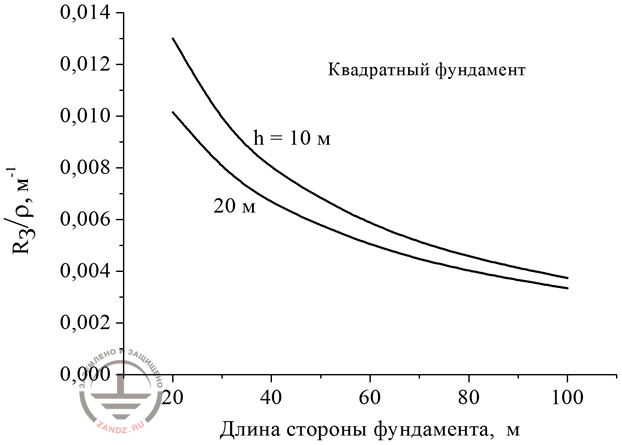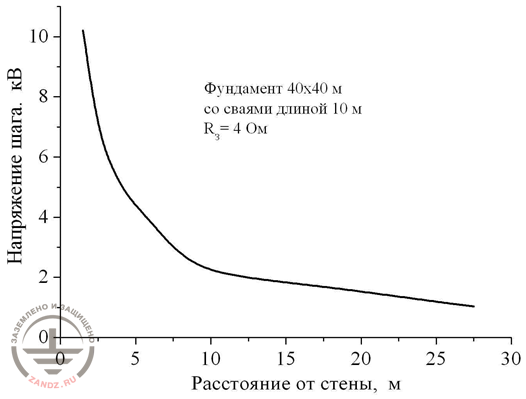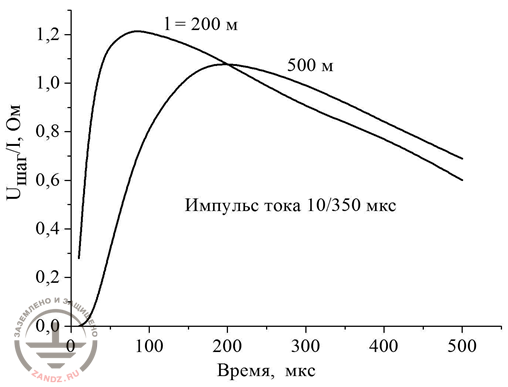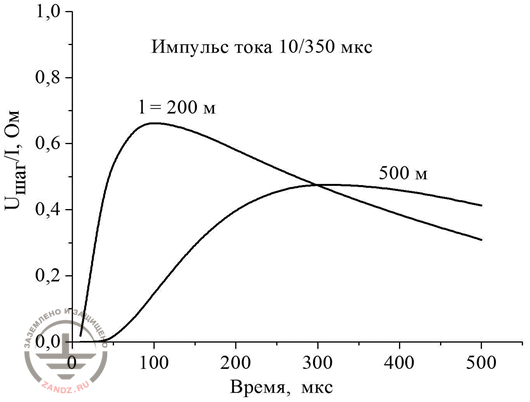The existing regulatory documents relating to lightning in general, and regulatory requirements to ground electrodes of lightning rods, in particular, do not link them with the object height. This is explained by the fact that, most often, this parameter is not determining. Since, in most cases, these objects have their own electrical substations. Accordingly, the requirements for grounding of the mentioned substation uniquely exceed those imposed to the building's ground electrodes by the degree of rigidity and the contour of the contour of the performed technological groundng is likely to be not separated from the ground electrode of the lightning protection installed.
The foundation of a high-rise building (strong enough) is often used as a basis for the grounding device. Moreover, the design of the foundation in this case is not crucial, since in any case, lightning current flows across the area occupied by the object base. And the probability that the electrodes used for grounding will advance significantly beyond the external perimeter of the foundation, is negligible.
In view of the above, the estimate of boundary technical possibilities of the area, allotted to accommodate the grounding device, can be easily performed. It is enough to formulate the following assumption. Suppose that the ground area under the existing foundation is completely filled with the metal electrodes up to the target depth, denoted as «h». The computer calculation held for the values h=10 m and h=20 m allowed us to construct the following chart
It is unlikely that the foundation will move deep to a greater depth. In addition, it should be noted that for objects of a large area the influence of the parameter in question can be considered insignificant.

Figure 1. The ratio of the minimum probable ground resistance to the foundation basement parameters*
Example. It is necessary to obtain Rз= 4 Ohm (for technological grounding, this indicator is considered to be classic). With a ground resistivity ≤ 500 Ω*m (at a ratio of Rз/ρ > 0.008 m-1) it is not difficult to achieve the required index, provided that the side of the object base exceeds 30.0 - 40.0 meters in length. But, as soon as the value ρ exceeds 1KOhm * m, and the ratio Rз/ρ <0.004 m-1, emergence of difficulties is quite predictable. Since the minimum length of each side of the foundation, in this case, will have to exceed 80 meters. They do not always reach the mentioned sizes at high-rise buildings.
In those cases where the electrical safety regulations do not allow you to select resistance (the value of which exceeds the above mentioned), inherent to grounding, it is necessary to hold unpopular measures:
- soil replacement;
- removal of the grounding construction outside the foundation perimeter;
- additional arrangement of the ground electroded mounted on a considerable depth.
It is important to understand that, introducing minor changes into the foundation, the desired effect cannot be obtained, as in the original model it was initially supposed that the entire area occupied by the foundation, was completely filled with ground electrodes
Changing of step and touch voltages
The question concerning the impact of the mentioned voltages is relevant due to a significant number of cases of lightning strikes into high-rise buildings. In this case, type of lightning does not play any role. Despite the fact that the limit currents of downward lightning are many times higher than that of the upward, the latter also must be considered. Since they are fully characterized by the ability to raise the potential at the ground surface to a value which represents a real danger for man and animals.
The curve in fig. 2 gives an idea of how the value of the step voltage changes depending on the moving the measurement point from the foundation of a high-rise building, the dimensions of which are 40*40 meters, and have piles buried 10 m deep. The presence of the latter allowed to bring Rз to the value of 4 ohms. The calculations were made for 30 kA currents (characterize lightning discharge, relating to the average intensity).

Figure 2. The step voltage at the base of the structure with a grounding resistance of 4 Ω at a lightning current of 30 kA*
Even at the distance of 5 meters from the external perimeter of the foundation, the voltage index remains in the range of 5 kV, that call cannot be safe for humans, especially if the soil surface at the given location is not isolated (at least with asphalt).
Figure 3 shows the calculated generalized curves characterizing the distribution of the step voltage at the foundations of various sizes (80*80 and 20*20) meters. These charts make it possible to assess the expected results for arbitrary lightning currents in all soils. Example. The object is located on the ground, has a specific resistance of 1 Kohms. A lightning strike with the current magnitude of 100 kA leads to a step voltage ≥ 10 kV even at the distance of 10 m from the considered foundation.
It is therefore not recommended for walking near high-rise buildings in a thunderstorm in cases where there is no sidewalk with an insulating coating on it (asphalt).
Dynamics of high voltage
This term is commonly referred to as high voltage transportation (moving) (Uвыс) along the underground or ground communications, which interconnect the objects located on the surface. If, at least one of the above-mentioned structures is high-rise, then the waves (Uвыс) are quite often sent from it to the others.

Figure 4. Voltage variation chart with the ground resistivity of 500 Ω * m*
An example can be seen in Fig.4. The calculation results presented in this chart demonstrate the dynamics of voltage change results over time in the course of its transmission over the distance of two or five hundred meters along the pipeline d = 100 mm. When performing the calculations, the following assumptions were used:
- lightning strikes into the building, having a ground electrode the resistance of which is 4 ohms;
- the pipe line is recessed to 500 mm into the ground, and its specific resistance index is 500 ohms.
You can see that the impulse transferred along this pipe line, decays very slowly. Its amplitude ≥ 100 kV even after 500 meters (at the current value of 100 kA). Such a voltage should be necessarily taken into account in the design of lightning protection on close objects. Even in case when the ground at the location of a high building has significant conductivity and it is assumed that the current leakages will rapidly and greatly deform the pulse, transferred along the pipeline, its real value is distributed to very cosiderable distances, in most cases.
This is confirmed by the results of calculations performed on the computer (see. Fig.16). In the example above, reduction of soil Rуд to the value of 200 ohms has led to an almost double decrease in the amplitude of the high potential. This reduction can not be regarded as fundamentally altering the degree of danger that a lightning strike has on animals and humans remotely.

Figure 5. Voltage variation chart with the ground resistivity of 200 Ω * m*
Conclusion
- Organizing lightning protection of structures that are high-rise, it is needed, first of all, to pay attention to the protection of the object from electromagnetic interference in its internal circuits, because the latter equally suffer from both downward and upward lightning strikes. The main measure conducive to the limitation of the arising interferences is qual distribution of max number of down conductors (preferably natural) of the lightning current.
- In the vicinity of the high-rise facility, it is necessary to carry out some works on covering the ground surface with the dielectric, which will play the role of human protection against touch and step voltages.
- Communications, located under the ground and on its surface, which connect the object with the neighboring high-rise buildings belong to high-risk sources, as it is exactly here where dangerous drifts of high potentials appear.
- It is considered an appropriate solution to free the roofs of high-rise facilities of any kind of equipment for any purpose, which will help to eliminate the problem of its disabling during a lightning storm. If there is an urgent need to implement the installation of the equipment mentioned directly on the roof, it should be protected by the system local destination lightning conductors (mesh, catenary wire, etc.)
* - illustrations are taken from the article of prof. E. M. Bazelyan "Lightning protection of high-rise buildings"
See also:
- What is offered by the companies manufacturing active lightning protection
- Album of standard solutions on grounding and lightning protection
- Video recording of the lecture "Answers to the questions of designers"
Related Articles:



